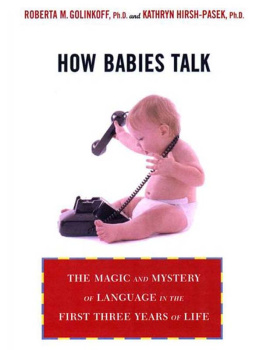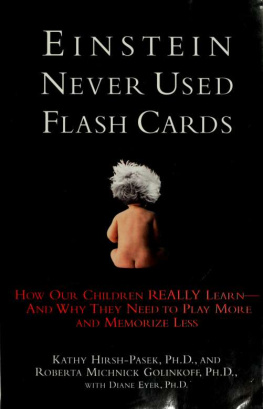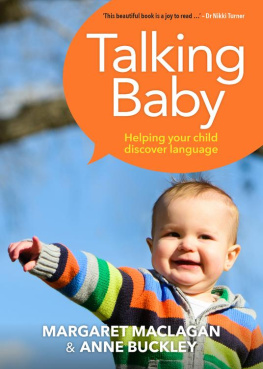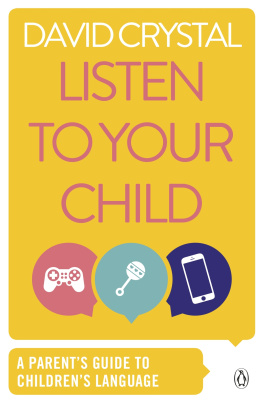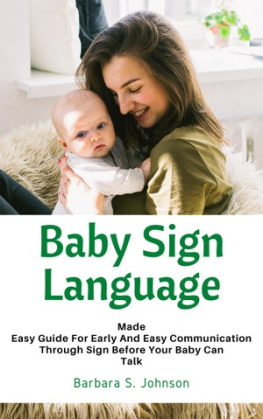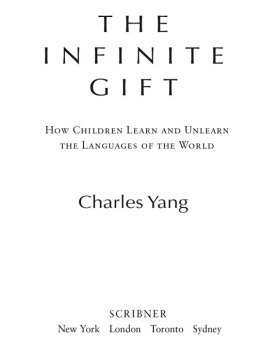This is a work of fiction. Names, characters, places, and incidents are either the product of the authors imagination or are used fictitiously, and any resemblance to actual persons, living or dead, business establishments, events or locales is entirely coincidental.
How Babies Talk
A Plume Book / published by arrangement with the author
All rights reserved.
Copyright 1999 by Roberta Michnick Golinkoff and Kathy Hirsh-Pasek
This book may not be reproduced in whole or part, by mimeograph or any other means, without permission. Making or distributing electronic copies of this book constitutes copyright infringement and could subject the infringer to criminal and civil liability.
For information address:
The Berkley Publishing Group, a division of Penguin Putnam Inc.,
375 Hudson Street, New York, New York 10014.
The Penguin Putnam Inc. World Wide Web site address is http://www.penguinputnam.com
ISBN: 978-1-1012-1308-7
A PLUME BOOK
Plume Books first published by The Plume Publishing Group, a member of Penguin Putnam Inc.,
375 Hudson Street, New York, New York 10014.
PLUME and the P design are trademarks belonging to Penguin Putnam Inc.
Electronic edition: February 2002
Roberta Michnick Golinkoff, Ph.D., received her doctorate from Cornell University. She is an H. Rodney Sharp Professor in the School of Education at the University of Delaware and directs the Infant Language Project. She holds joint appointments to the departments of linguistics and psychology. She has also been a recipient of the John Simon Guggenheim Fellowship.
Kathy Hirsh-Pasek, Ph.D., is a member of the psychology department at Temple University, where she directs the Infant Language Laboratory. She received her Ph.D. in human development and psycholinguistics from the University of Pennsylvania. She is also a composer and performer of childrens music. Together, the authors were featured on the PBS Human Language series.
To our mothers, Joan and Anne, whose drive and determination we hope we have inherited. Good talkers themselves, they served as our role models for how to talk, and how to listen.
To our children, Jordan, Allison, Josh, Benj, and Michael, who gave us a birds-eye view of what comes out of the mouths of babes.
And to our husbands, Jeff and Elliott, whose constant encouragement and support made this dream a reality.

It is always the case that in an undertaking of this magnitude, there are many people to thank. First and foremost, we wish to offer special thanks to our colleagues from around the world. Their scientific discoveries made this book possible. Their inspired work paved the way for our understanding of languagethe pinnacle of human behavior. Though their names cannot all be mentioned here, they stand with us in having contributed to the exciting story of language development. In that very real sense, this book is theirs, too, although they may not agree with all our interpretations.
Much of the research described in this book could not have been conducted were it not for the research support provided by government agencies, private foundations, and educational institutions. In our own case, our research has been supported by both the National Science Foundation and the National Institutes of Child Health and Human Development. In addition, Golinkoff has been supported by a James McKeen Cattell Sabbatical Award and a John Simon Guggenheim Memorial Fellowship. Hirsh-Pasek has held a number of grants from the Pew Foundation.
Having children who have mastered language is a great boon. Benj Pasek and Allison Golinkoff offered critical reviews of some of these chapters. With keen eyes and direct, no-nonsense commentary, they helped their scientific mothers learn how to write for a broader audience. Many thanks to our editors, Deborah Brody and Jennifer Moore, who greatly improved our writing, and to our agent, Barbara Lowenstein, who had faith in this book. Thanks also go to Maryanne Bowers and Doris Davidson at the University of Delaware, who helped in preparing the bibliography. George Hollich, He Len Chung, Camille Rocroi, and Michelle McKinney also deserve our thanks. They kept our laboratories running so smoothly that we were able to concentrate on writing this book.
Finally, thanks to all the children and parents from around the world who participated in the research projects described here. Were it not for their participation, we would know much less about childrens amazing ability to learn a human language. The parents, students, and professionals who read this book are benefitting, too, from the willingness of children and parents to allow scientists like ourselves to probe the workings of the developing human mind.

Setting the Stage:
The Magic of Language Development in the First Three Years of Life
Communicating through language is the crowning achievement of the human species. Dogs cant do it. Whales cant do it. Even our evolutionary cousins, the great apes, cant do it. Yet within every infant lies the potential to learn a language. Equipped with the power of words, every one of us can talk about a future and resurrect a past. With language we can mentally move through time and space unlike any other species.
Through human language we have transformed our planet and launched spacecraft to Pluto. Through well-chosen words a three-year-old can exclaim that she wants the red cup with the giraffe on it, not the blue cup with the elephant. Language enables us to embrace an idea, to share our feelings, to comment on our world, and to understand each others minds. Precisely because language is so pervasive, we fail to realize the remarkable capabilities that we take for granted. Trying to appreciate the complexities of language is somewhat like trying to appreciate the design of your eyeglasses while you are looking through them. With your glasses on, you gain a whole new perspective on the worldbut you never stop to consider how your glasses actually work.
In the past several decades, specialists in the field have made enormous progress in understanding the intricacies of learning to talk. When you realize that you can chat on the phone for hours without ever planning what you are going to say or can generate a sentence that is as long as this one by stringing together a limited set of building blocks like nouns and verbs, you begin to see the vastness of the system that young children have to learn. We have no problem turning a sentence like this one into a question. (Do we?) And it is a commonplace assumption that a word like window can be widely applied to such instances as the stained-glass depictions in a church or the window opened on a computer screen. How do we know when to use the word window? What does window really mean? How do children ever learn to use words correctly?
As we begin to scratch the surface, we see that there is a great deal of extraordinary in the ordinary. The achievements of chess grand masters, musical virtuosos, and Olympic athletes hardly match what children accomplish in language learning by the tender age of three or four years. How do children do it? How do they learn to get their tongues in just the right place to pronounce a word? How do they learn those noun and verb building blocks that allow them to construct sentences? How do they learn the difference between I eat to live and I live to eat? These questions lie at the foundation of the mystery of language development.
Where can the answers to these questions be found? A commonsense approach was taken by our grandmothers. How do children learn language, you ask? Its obvious. Parents teach their children to talk.

